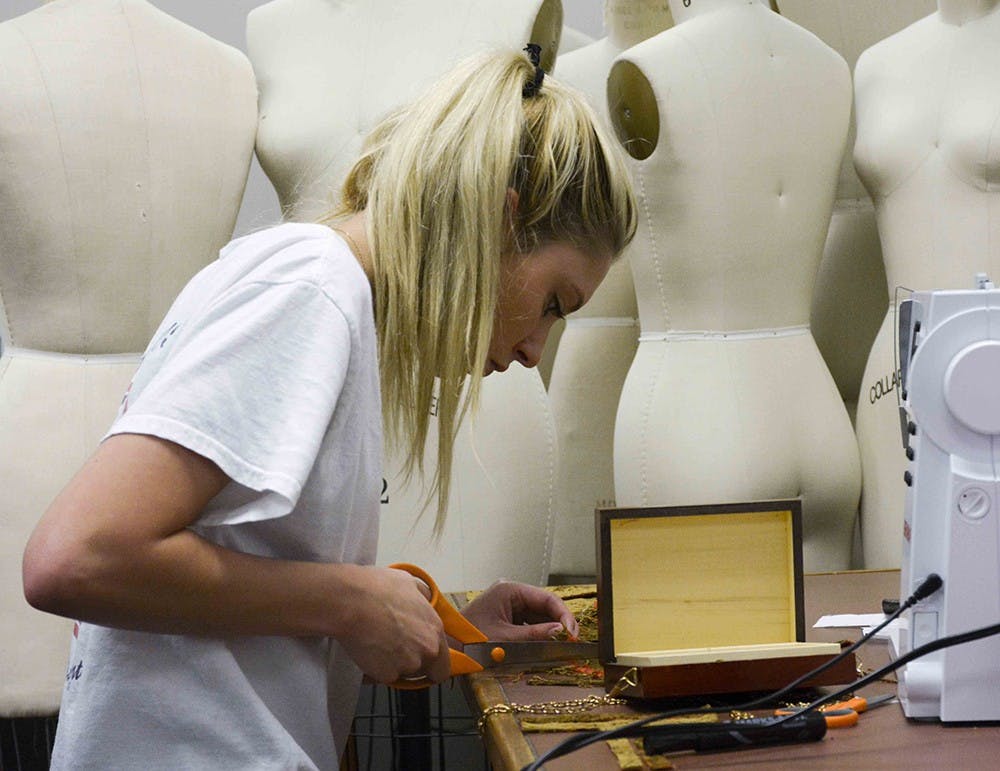When people get bored with their closets, the usual solution is to add something new. However, a superior answer might not include a trip to the mall, but instead reusing or recycling something at home.
Perhaps the solution is something that is old or used that can be made into something new. At least that’s what Indiana University lecturer Mary Jane Matranga believes.
While many might find it difficult to see how a jewelry box can be transformed into a satchel or how a newspaper is shaped into paper machete earrings, Matranga’s latest course, experimental fashion studio accessories design, proves that nearly any material, including trash, can be reused into something extraordinary.
“I think it’s a really fun and wonderful mental exercise to let some object that seems out of the blue crazy inspire you to make apparel out of it,” says Matranga. “It gives rebirth to old things that people cast aside.”
As Matranga’s course requires students to create accessories strictly from recycled materials, the results prove that even the most unthinkable objects can recreate iconic fashion statements.
While some may doubt the ability to turn old items into a chic and astonishingly new handbag, junior Sarah Ferguson proves that the possibilities available through reused materials are unlimited.
Ferguson’s inspiration came from the popular brand Kate Spade, which is known not only for its sleek leather handbags, but also its more creative clutches in the shape of books, purses in the form of a teapot and countless handbags disguised as different objects.
Ferguson took Kate Spade’s iconic style and added a touch of the Kentucky Derby as she finally decided what direction to take her purse. She found an old basket, a yellow, cotton-polyester blend men’s dress shirt and plastic lemons.
Ferguson will spray paint the basket white, line the inside with a pastel yellow men’s dress shirt and then decorate the top with plastic lemons. The purse will appear as a basket full of lemons, but instead open up to be a full-functioning handbag made out of these items Ferguson found at Goodwill and in her mother’s basement.
When making a garment with new materials in the past, Ferguson always dreaded how much fabric that would be thrown away, because it went unused. This is one of the reasons she enjoys reusing and recycling materials for her creations.
“It’s something that’s already made, it’s already gone through that wasteful process, it’s already wasted enough as it is, so taking that and being able to make it into something new and completely changing the whole idea about its use and purpose; you’re giving it another life, you’re extending the life of these materials — which I think is just great for the environment,” says Ferguson.
While there are countless approaches to creating something new out of something old, there are also ways to help out the environment simply as a shopper.
Matranga notes that it’s important that consumers know that the production of certain fabrics bare a heavier burden on the environment than others.
She states that cotton not only requires extremely large amounts of water during production, but the fabric is also made with pesticides and bleach, which not only damages the eco-system, but also effects the health of workers inhaling these substance as they make this material.
On the other hand, there are also fabrics helping decrease our eco-footprint.
Matranga mentioned an especially helpful material called recycled polyester. The fabric is made by melting down plastic bottles, chopping them into chips and turning it into a solution which is then spun into yarn to make the textile.
Being an eco-friendly fashionista doesn’t require having a closet that is strictly made out of recycled objects or attire. Small steps like turning an oversized IU shirt into a cute crop top instead of garbage or checking a clothing tag to see what a dress is made out of can go a long way.
While some may fear reaching outside the box in this approach to eco-friendly fashion, Matranga encourages it.
“Just get creative and artistic about it,” say Matranga. “Don’t be afraid to wear something that might look a little funky or bizarre.”






